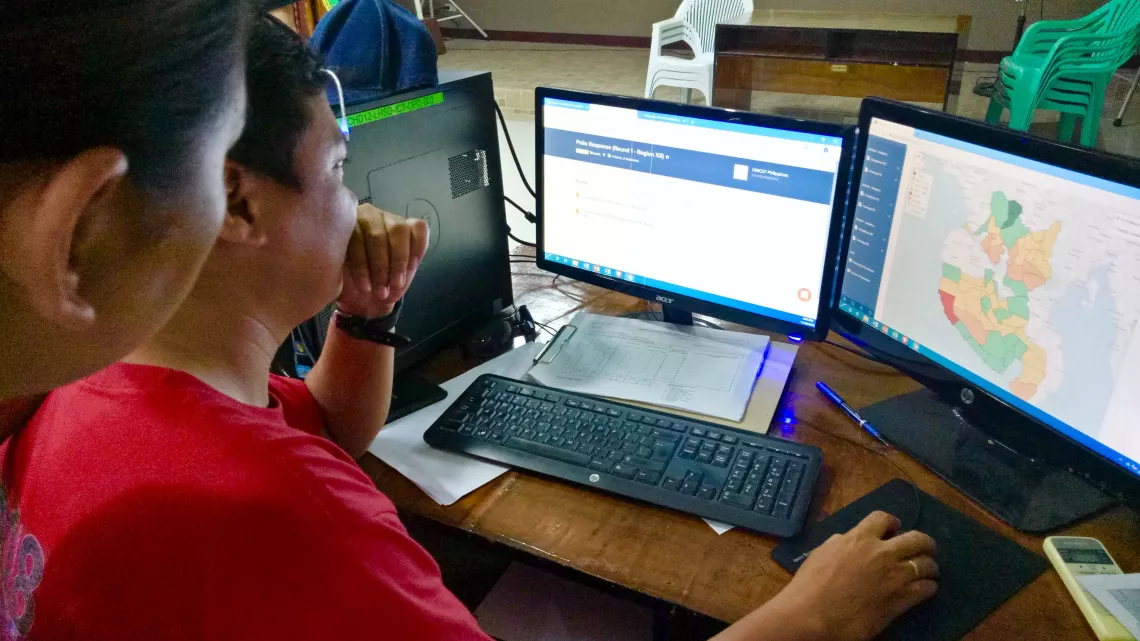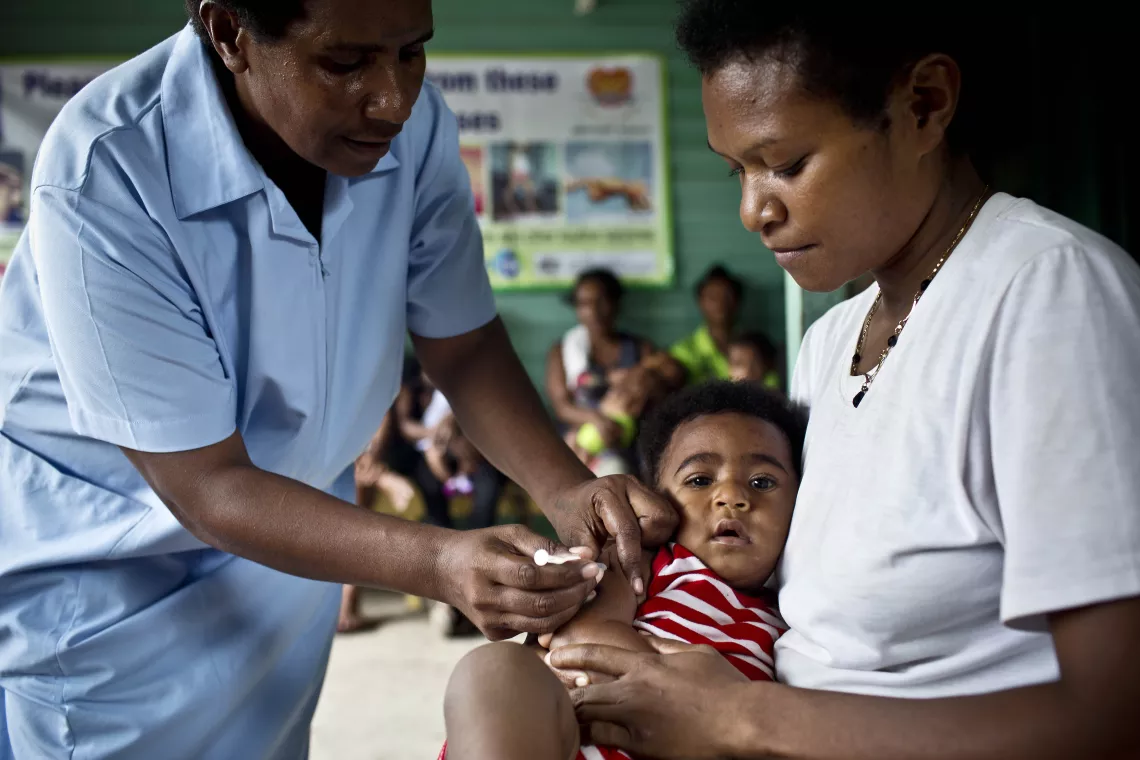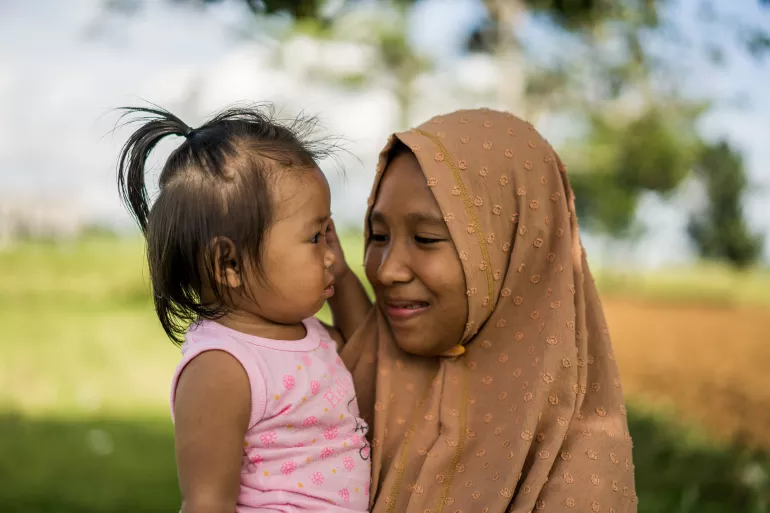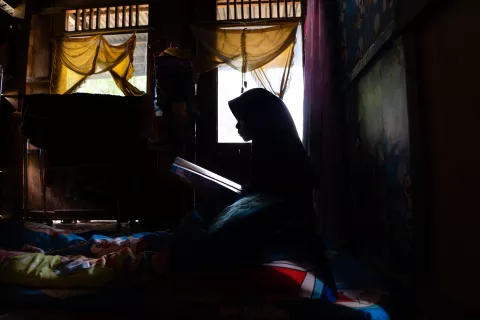Jonaila, a curious two-year-old is yet to receive her first measles and rubella vaccination. One that should be given within the first 12 to 15 months of a baby’s life. She lives with her mother, in the Bangsamoro region in the Philippines which is home to 60 per cent of the country’s ‘zero dose’ children.
Her mother, Jamila, gave birth to her at home during the pandemic. Jamila is pregnant and plans on giving birth at home again because the health centre is too far away for her. She also fears reprimands from the health workers when they find out that Jonaila did not receive her routine vaccinations. Jamila is hopeful that both her children will be safely vaccinated.

In Papua New Guinea, mother of four, Francisca and her 6 months old son Manuel, were turned away from clinics when she tried to get her children vaccinated during the pandemic. Despite the rumours and misconceptions that circulated in the community around COVID-19 vaccinations, Francisca remained determined to ensure her children were vaccinated and protected. Unfortunately, her son, Manuel’s immunization could not be prioritized since clinics were busy with COVID-19 outbreaks and vaccinations.

“My baby was 6 months old when I took him to the clinic for his routine immunization, but the clinic was closed. I wanted to have him vaccinated but we were sent back because the spread of COVID-19 in the country was high at the time…there was nothing we could do so we just stayed at home.”
Jonaila, from the Philippines, and Manuel, from Papua New Guinea, are not alone in this precarious situation. They are two out of the 2.5 million children in East Asia and Pacific that are lagging in their childhood immunizations and are therefore prone to life-threatening diseases.
Due to the disruptions caused by the pandemic, the increase in the number of zero-dose children was particularly alarming in Indonesia, Myanmar and the Philippines. Globally, the East Asia and Pacific region had the most drastic decline in vaccine coverage, from 92% in 2019 to 82% in 2021. In the Philippines and Papua New Guinea, like in most countries, the drop in vaccinations was caused by the intense pressure on public health systems to respond to the pandemic and to roll out COVID-19 vaccinations. Prolonged lockdowns also curtailed routine clinic visits for families like Jonaila’s and Manuel’s, increasing the risk of missing their essential vaccines.
To be able to urgently reach millions of children, like Jonaila and Manuel, with their missed doses, governments needed to identify, locate and vaccinate them at the nearest health facilities or even in some cases, at their doorsteps. This is where digital technologies are offering solutions. Technology can help close the gap by creating access to reliable data that allows governments and partners to identify the areas and children who are getting missed out. UNICEF is supporting the scale-up of digital health solutions, such as Real-time Vaccination Monitoring and Analysis (RT-VaMA), to help governments better plan, implement and evaluate immunization campaigns.
How can RT-VaMA help?
RT-VaMA presents a solution to help reach the 2.5 million zero-dose and under-vaccinated children in the East Asia and Pacific region with faster and timely immunization through real-time monitoring. It supports rapid scale-up of immunization campaigns so that governments can reach the under-vaccinated or zero-dose children more efficiently as it allows health workers to gather data electronically and upload on a regular basis.
RT-VaMA addresses common challenges that public health facilities in countries like the Philippines and Papua New Guinea face when using paper-based systems to record vaccine-related data. Processing this data manually or on paper is problematic for several reasons. It is more prone to human error, the processing time is longer and more laborious, physical records are at risk of spoiling due to disaster, conflict and turnover in health staff can impact data continuity. Additionally, the information rarely reaches decision-makers in time to inform annual planning, resulting in wasted resources and less effective campaigns.
RT-VaMA empowers health officials to identify children like Jonaila and Manuel, who missed out on their vaccinations, and follow up with their parents or caregivers. Issues with vaccine supplies in health centres can more easily be tracked and addressed more efficiently.

Where are we now?
Building on the success of RT-VaMA in the Philippines, UNICEF Philippines developed the RT-VaMA toolkit. This toolkit supports the adoption of RT-VaMA in different country contexts. In 2023 the RT-VaMA toolkit has been used in the Philippines and Papua New Guinea. In the Philippines, nine million children are targeted for immunization against measles, rubella and polio across 18 regions. Whilst in Papua New Guinea, 1.3 million children are targeted for immunization against measles and rubella across 22 provinces.
UNICEF aims to build further on these experiences to support the uptake and adaptation of RT-VaMA in other country contexts. The experiences and lessons learned so far are being used to further evolve and strengthen the technology so that it can be adapted differently in different countries, depending on their needs.
Investment in Digital Health initiatives, such as real-time monitoring, can help to improve health systems, enhance the quality and reach of vital health information and services and reach the most disadvantaged children and their families. With the rapid uptake of digital technology in East Asia and the Pacific countries, tools like RT-VaMA can transform health systems and lead to long-term benefits for children like Jonaila and Manuel, who are at higher risk of missing their life-saving vaccines and other essential health services.

“Digital Health is still new in Papua New Guinea. Currently there is a gap with digital knowledge in PNG and hopefully the government can now see how digital technology can be used to improve health outcomes here – through the use of real-time monitoring in RT-VaMA. I am very happy we are going this digital way because Papua New Guinea will benefit hugely from digital transformation.”
RT-VaMA is being scaled with the support of the UNICEF East Asia and Pacific Regional Office’s (EAPRO) ICT and Digital Innovation team, the UNICEF Philippines Country Office, and the UNICEF Office of Innovation. The EAPRO Frontier Data Tech Node and UNICEF’s InForm team focus on improving frontier data and the use of real-time data respectively to advance child rights – they are advising governments and UNICEF country offices on the benefits of RT-VaMA.






